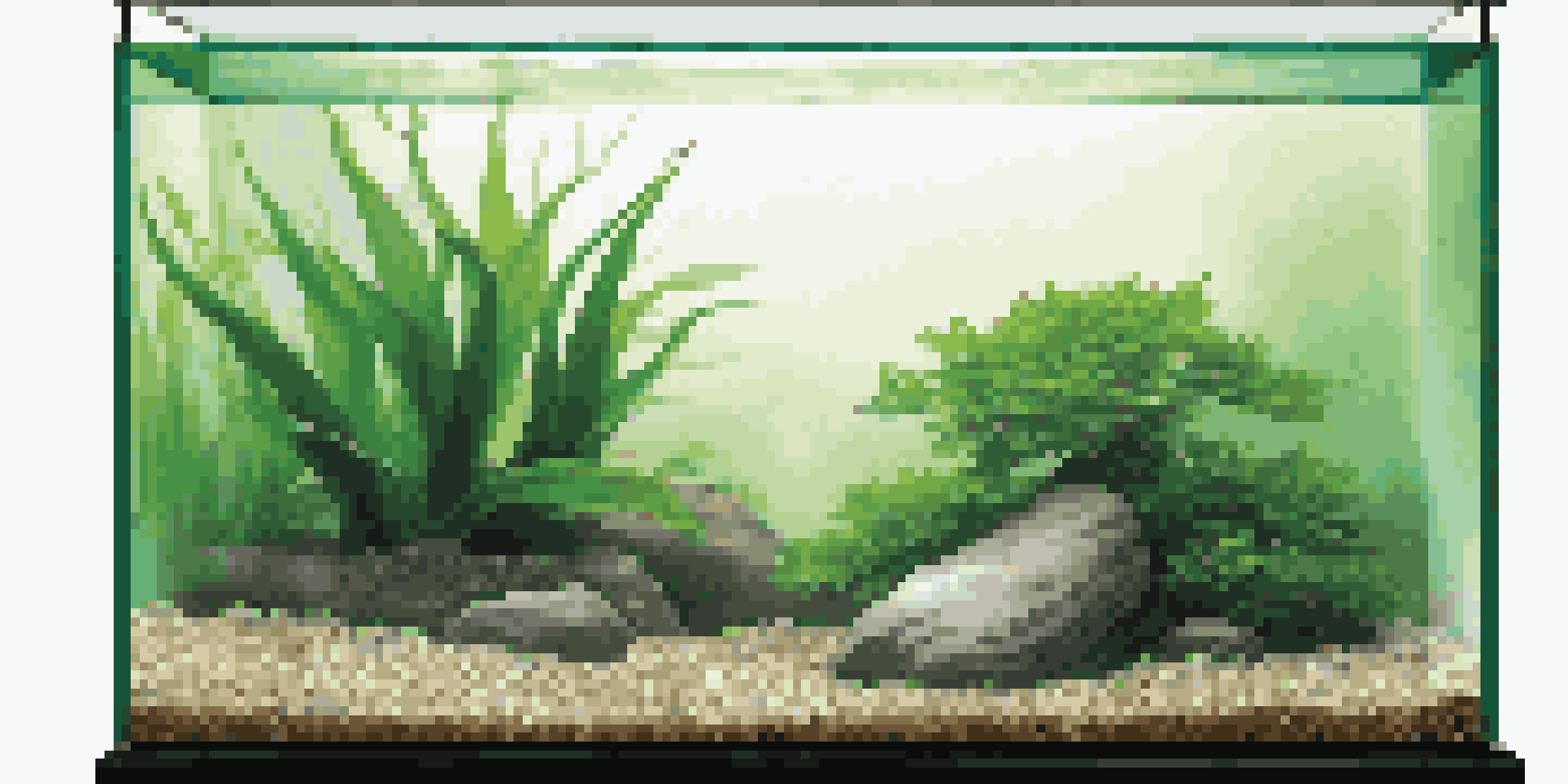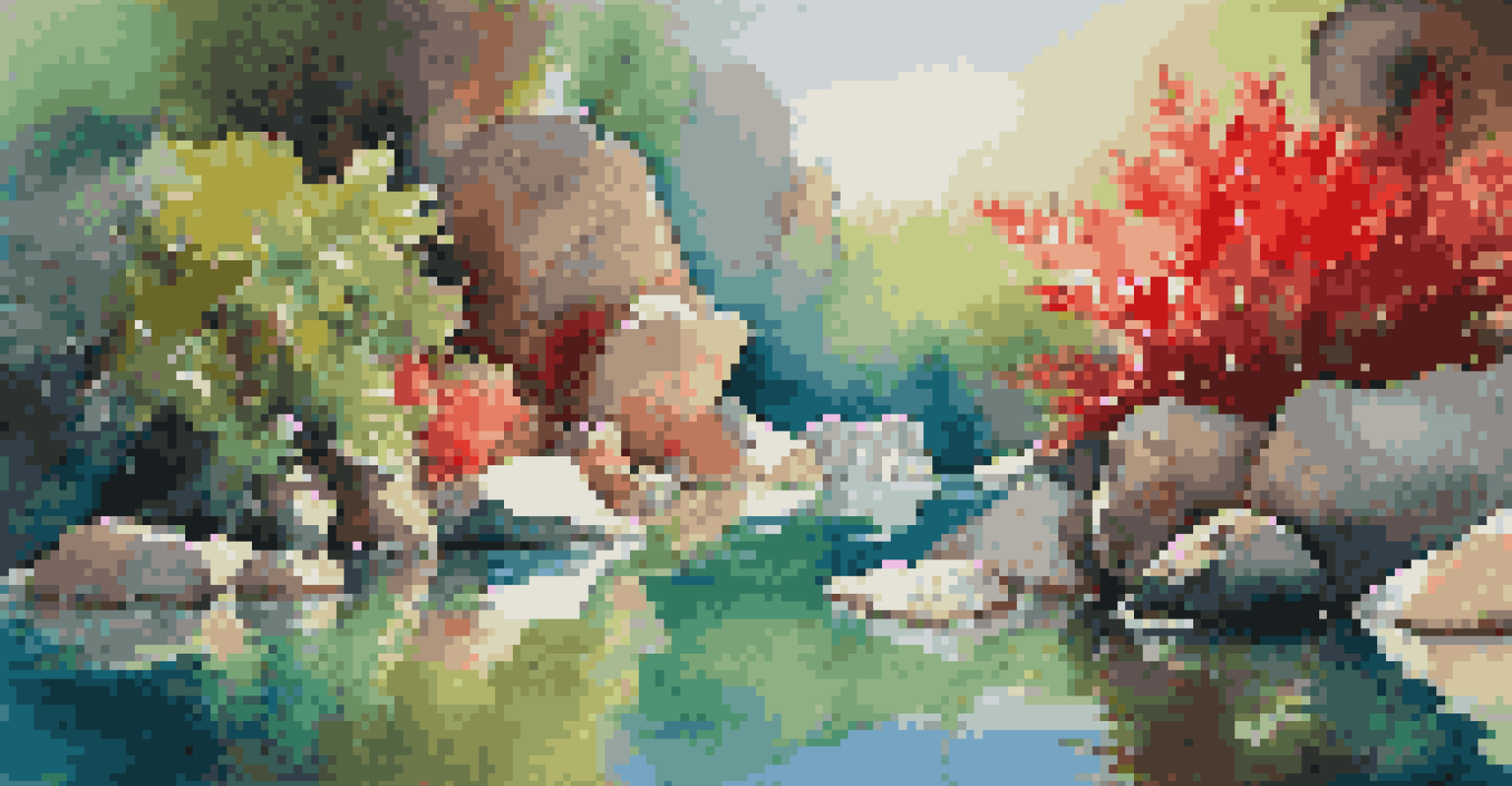Creating a Focal Point in Your Aquascape Design

Understanding the Importance of a Focal Point
A focal point is essential in aquascape design as it draws the viewer's eye and creates a sense of harmony. Imagine walking into a room; if your gaze is immediately caught by a stunning piece of art, it elevates the entire space. Similarly, in aquascaping, a well-placed focal point can transform a simple aquarium into a captivating underwater landscape.
Design is the silent ambassador of your brand.
The focal point serves as an anchor for the rest of your design, giving it structure and balance. Much like a well-composed photograph, where the subject stands out against a blurred background, your aquascape needs a distinguishing feature that stands out. This could be a striking piece of driftwood, an unusual rock formation, or a vibrant plant arrangement.
Without a focal point, an aquascape can feel chaotic or disjointed, lacking the flow and coherence that makes it appealing. Think of it as the difference between a well-planned garden and a wild, overgrown patch. A thoughtfully chosen focal point not only enhances the visual appeal but also encourages exploration and appreciation of the entire layout.
Choosing the Right Focal Point for Your Aquascape
When selecting a focal point, consider the overall theme and style of your aquascape. Are you aiming for a natural, serene look, or something more dramatic and modern? For instance, a tall, elegant plant can serve as a focal point in a minimalist design, while a cluster of colorful rocks might work better in a vibrant, dynamic setup.

It's also vital to think about the size and scale of your chosen focal point relative to the aquarium. A large piece may overwhelm a small tank, while a tiny accent can easily get lost in a larger space. Visualize how the focal point will interact with the surrounding elements; it should complement them, not compete for attention.
Focal Points Enhance Aquascapes
A well-chosen focal point creates harmony and draws the viewer's eye, transforming an ordinary aquarium into a captivating underwater landscape.
Additionally, consider the colors and textures of your focal point. A contrasting color can enhance visibility, while similar hues might create a more harmonious feel. For example, if your aquascape is predominantly green, a bright red plant can stand out beautifully, drawing the eye and adding interest.
Placement Strategies for Your Focal Point
Placement is crucial when creating a focal point in your aquascape. A common technique is the 'Rule of Thirds,' where the focal point is positioned off-center to create a more dynamic composition. Imagine dividing your tank into thirds, both horizontally and vertically, and placing your focal point at one of the intersections; this often leads to a more engaging design.
Simplicity is the ultimate sophistication.
Another effective strategy is to ensure that your focal point is visible from multiple angles. If your aquarium is viewed from one side, make sure the focal point doesn’t have its back turned to the viewer. This way, regardless of where someone stands, they can appreciate the beauty of the focal element.
Lastly, consider the surrounding elements when placing your focal point. Surround it with complementary plants or decor to enhance the overall design. However, be cautious not to overcrowd the area; a little negative space around your focal point can help it stand out even more.
Incorporating Texture and Color in Focal Points
Texture and color play significant roles in making your focal point stand out. For instance, a rough piece of driftwood can create a striking contrast against smooth, vibrant plants. This contrast not only draws the eye but also adds depth and interest to your aquascape, inviting viewers to explore further.
Moreover, using color strategically can enhance the visibility of your focal point. Brightly colored plants or decorative stones can serve as effective focal points, especially in a predominantly green or blue aquascape. Think of it like dressing up for an event; a pop of color in your outfit can turn heads and grab attention.
Placement and Scale Matter
Strategically placing your focal point using techniques like the 'Rule of Thirds' ensures it complements the overall design without overwhelming the aquarium.
Incorporating different textures can also create visual intrigue. Pairing soft, flowing plants with rugged rocks or driftwood can create a balanced and appealing aesthetic. This interplay of textures encourages viewers to appreciate the complexity of your design and keeps their attention focused on the focal point.
Creating Depth Around Your Focal Point
Creating depth around your focal point can enhance its prominence and make your aquascape feel more three-dimensional. Layering plants of varying heights can lead the eye naturally toward the focal point, much like a winding path that guides a visitor through a garden. This layered effect not only adds interest but also mimics natural underwater landscapes.
Consider using smaller plants or gravel in the foreground to frame your focal point. This technique draws the viewer's eye inward, creating a sense of perspective and depth. It's akin to how a well-framed photograph pulls attention to the subject while providing context.
Additionally, incorporating hardscape elements, such as stones or driftwood, can further enhance depth. Arranging these pieces at varying angles and heights can create shadows and highlights, adding to the three-dimensional effect. This interplay of light and shadow invites viewers to explore your aquascape, making the focal point even more captivating.
Adjusting and Refining Your Focal Point Over Time
Aquascaping is an evolving art form, and your focal point may need adjustments as your plants and decor grow. Regular maintenance, such as trimming or repositioning plants, can help maintain the integrity of your focal point. Just like a gardener prunes their flowers to keep them vibrant, you too can enhance the beauty of your aquascape with thoughtful adjustments.
Don't hesitate to experiment with your focal point as well. If something isn't working or you feel your focal point has lost its impact, consider changing its position or replacing it altogether. This trial-and-error approach can lead to exciting new designs and unexpected discoveries, much like finding a hidden gem in your garden.
Textures and Colors Create Interest
Incorporating contrasting textures and vibrant colors around your focal point enhances its visibility and adds depth to your aquascape.
Moreover, as your aquascape matures, new focal points may naturally emerge. Pay attention to how the plants grow and interact over time; sometimes, a previously minor element can become a stunning focal point. Embracing these changes can lead to a dynamic aquascape that continuously captivates.
Inspiration for Creating Focal Points in Aquascaping
Finding inspiration for your focal point can come from various sources, including nature, art, and even photography. Visiting botanical gardens or natural bodies of water can spark ideas for unique shapes and arrangements to incorporate into your aquascape. Observing how nature creates focus can provide valuable insights into your design.
Online platforms, like Pinterest or Instagram, are also treasure troves for aquascaping inspiration. By exploring different styles and setups, you can identify trends and techniques that resonate with your vision. Don't be afraid to adapt and combine elements from various designs to create your own unique focal point.

Lastly, consider engaging with the aquascaping community. Joining forums, attending workshops, or participating in local competitions can expose you to diverse ideas and styles. Sharing your journey and learning from others can enrich your experience and inspire the creation of your perfect focal point.